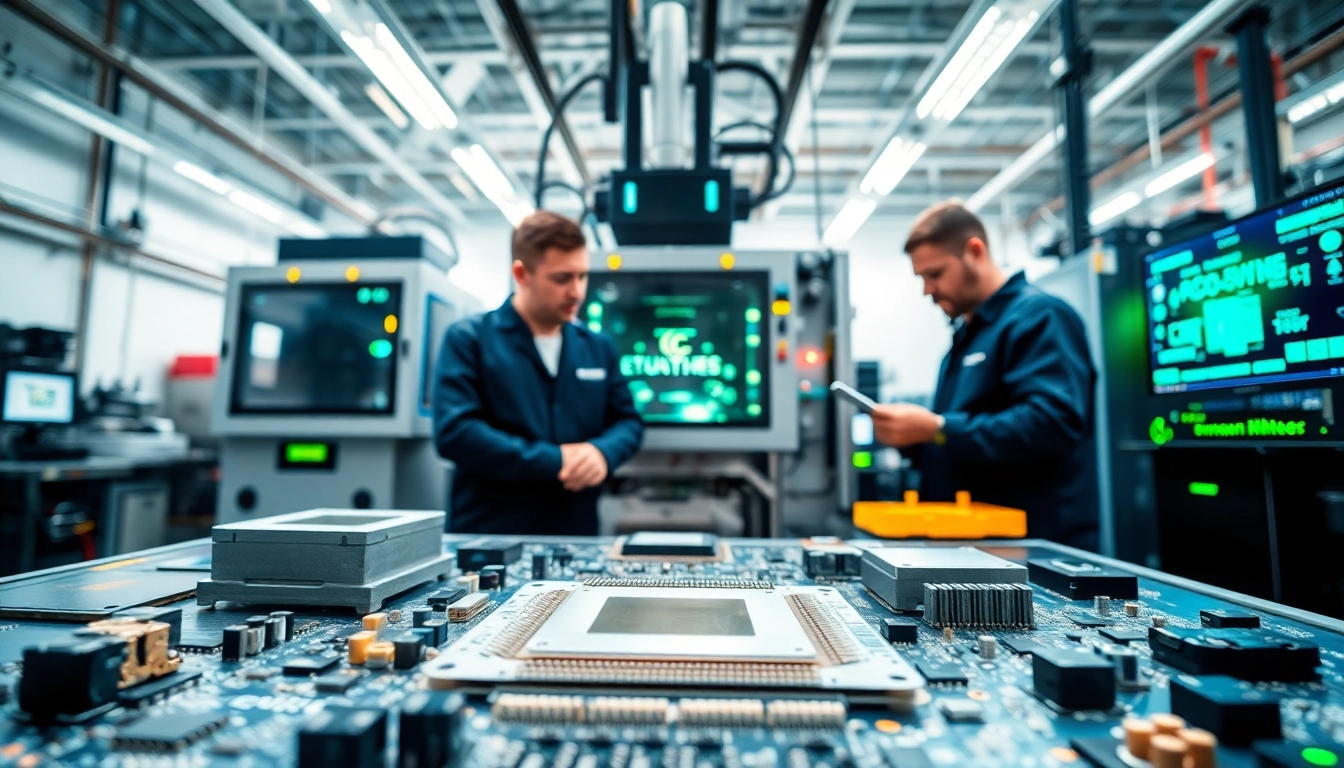The Importance of Microchips in Today’s Economy
Microchips, the tiny yet powerful components that drive our most important technologies, have become the backbone of virtually every industry in today’s economy. Their role extends far beyond consumer electronics; they are fundamental to sectors such as automotive, telecommunications, healthcare, and even renewable energy. As industries increasingly rely on advanced digital systems, the demand for microchips continues to surge, making it essential to understand their influence, implications, and the challenges ahead in microchip production. For a deeper dive into the current landscape of MICROCHIPS, let’s explore the intricate world of microchip technology.
Overview of Microchip Technology
Microchip technology has undergone rapid evolution since its inception in the mid-20th century. Modern microchips, also known as integrated circuits (ICs), are complex assemblies of electronic components that can execute a multitude of tasks. These components function by managing electrical signals and data across everything from smartphones to industrial machinery. The most essential types of microchips include:
- Microprocessors: The heart of computers and smartphones, enabling computational capabilities.
- Memory Chips: Essential for data storage and retrieval, used in everything from RAM to flash drives.
- Application-Specific Integrated Circuits (ASICs): Customized for specific tasks, often utilized in specialized equipment.
- Digital Signal Processors (DSPs): Optimized for processing digital signals in real-time, critical in audio and video equipment.
The advancement of Moore’s Law has allowed manufacturers to create increasingly powerful and smaller chips. However, the latest trend indicates that innovation now moves beyond just miniaturization to include enhanced efficiency, sustainability, and integration of artificial intelligence (AI).
Impact on Global Supply Chains
The sheer importance of microchips in global supply chains cannot be overstated. Every segment of the economy is affected by their availability, as microchips represent a pivotal component in manufacturing processes. The COVID-19 pandemic highlighted this vulnerability, resulting in significant delays and shortages across multiple industries. Major impacts include:
- Automotive Shortages: Automakers experienced production stoppages due to a lack of microchips, which caused delays in vehicle deliveries.
- Consumer Electronics Delay: Tech companies could not meet the increasing demands for electronics as supply chains experienced disruption.
- Increased Costs: Manufacturers faced rising materials costs, which trickled down to consumers and impacted inflation rates.
These impacts emphasize the need for a resilient schedule that assures consistent production flow, indicating a pressing necessity for domestic production capabilities and diversified sourcing strategies.
Future Trends in Microchip Development
As we look towards the future, several key trends are emerging in microchip development:
- Advanced Node Technology: The shift to 5nm and smaller scale nodes promises increased performance and energy efficiency.
- AI Integration: Microchips are increasingly being designed to support AI applications, speeding up processing for machine learning tasks.
- Sustainability Focus: Manufacturers are exploring environmentally friendly production methods and materials to meet regulatory standards and consumer expectations.
As these trends develop, they will not only redefine the capabilities of microchips but also alter the competitive landscape of the industry as companies invest in innovative technologies.
Challenges Facing the Microchip Industry
Despite the advancements and potential of the microchip industry, significant challenges remain that hinder growth and innovation. Understanding these challenges is critical for stakeholders looking to enhance their strategic approaches.
Supply Chain Disruptions
Supply chain disruptions have been a primary concern for the microchip industry, exacerbated by global events that have strained logistics and manufacturing capabilities. Key factors contributing to these disruptions include:
- Geopolitical Tensions: Ongoing trade disputes, particularly between the U.S. and China, have led to tariffs and sanctions impacting component availability.
- Pandemic Effects: Factory shutdowns, labor shortages, and logistical challenges during COVID-19 revealed weaknesses in the global supply chain.
- Natural Disasters: Hurricanes and earthquakes have affected chip manufacturing facilities and disrupted local supply networks.
Tackling these issues requires a multi-faceted approach, including diversification of supply sources, localized production, and robust risk management strategies.
Competition from Global Markets
The microchip industry faces fierce competition from various global markets. Countries like Taiwan, South Korea, and China have heavily invested in their semiconductor industries, creating formidable rivals for U.S.-based companies. Challenges presented by this competition include:
- Cost Efficiency: Manufacturers in these countries often benefit from lower production costs, risking the market share of American firms.
- Technological Advancements: Many leading countries are advancing their technological capabilities, which can eclipse U.S. companies that do not keep pace.
- Government Incentives: Foreign governments often provide financial incentives and subsidies that can make domestic competition challenging.
To maintain a competitive edge, U.S. companies must innovate and explore collaboration opportunities with international partners.
Technological Limitations
The nature of microchip technology creates inherent technological limitations that present ongoing challenges. These challenges include:
- Material Constraints: The reliance on silicon and other raw materials can lead to bottlenecks in production as demand continues to surge.
- Design Complexity: As microchips grow more intricate, the engineering required to design them becomes exponentially more complex, heightening the potential for errors.
- Innovation Pace: Keeping up with the rapid pace of technological change requires significant investment in R&D, not all companies can afford.
Overcoming these limitations will necessitate inventive solutions and dedicated research efforts focused on material science and engineering.
Strategies for Strengthening American Microchip Production
Addressing the challenges facing the microchip industry requires strategic actions from both governmental and corporate levels. Here are several essential strategies that can help strengthen American microchip production:
Investing in Research and Development
One of the most critical avenues to bolster the microchip sector is increasing investment in research and development. This investment allows for:
- Innovation: Funding can be directed toward developing next-generation technologies, enhancing the capabilities of microchips.
- Collaboration: Joint research initiatives between companies and academia can share knowledge and accelerate technological advancements.
- Talent Development: R&D investment also supports the cultivation of a highly-skilled workforce that is adept in areas like nanotechnology and semiconductor physics.
Government grants and tax incentives for R&D can further stimulate private sector investment, fostering a fertile ground for groundbreaking advancements.
Pursuing Government Policies and Incentives
Government intervention can play a crucial role in revitalizing the American microchip industry. Effective policies and incentives can include:
- Tax Breaks: Providing tax incentives or subsidies can lower the financial burden on companies investing in new manufacturing capabilities.
- Trade Policies: Implementing fair trade agreements can protect U.S. companies from unfair foreign practices.
- Infrastructure Investment: Increasing funding for the physical infrastructure necessary to support microchip production, ensuring efficient logistics and distribution.
Through deliberate policies, the government can create an environment that fosters growth and resilience in the microchip production landscape.
Collaboration with Educational Institutions
Forging partnerships with educational institutions is another pathway to strengthen the microchip industry. By collaborating with universities and technical schools, companies can:
- Develop Curricula: Work together to create relevant programs that align with industry needs, cultivating a workforce equipped with necessary skills.
- Internship Programs: Establish internships that offer real-world experience for students in microchip technology.
- Access Research Facilities: Companies can utilize university labs to support their R&D initiatives, fostering innovation.
These collaborations can lead to a more knowledgeable workforce that is capable of tackling the industry’s complexities and challenges.
Best Practices for Microchip Manufacturing
Manufacturing high-quality microchips involves adhering to best practices that ensure efficiency and sustainability. Companies must adopt strategies that minimize waste and uphold rigorous quality standards:
Quality Control Measures
Establishing stringent quality control measures is paramount in microchip manufacturing. Effective strategies include:
- Testing Protocols: Implement regular testing at various stages of production to detect issues early and ensure product reliability.
- Standards Compliance: Adhere to international standards and industry benchmarks, such as ISO 9001.
- Quality Management Systems: Develop robust systems for managing quality across the supply chain, emphasizing traceability and accountability.
By prioritizing quality, manufacturers can bolster their reputation and reduce costs associated with defects and recalls.
Adopting Automation in Production
The integration of automation in microchip production can significantly increase efficiency and reduce costs. Key automation practices include:
- Robotic Process Automation (RPA): Utilize robots to perform repetitive tasks and assembly line operations, minimizing human error.
- Machine Learning Algorithms: Deploy AI to analyze production processes and optimize workflows based on real-time data.
- Smart Sensors: Implement sensors to track equipment efficiency and predict maintenance needs, reducing downtime.
Automation not only increases output but also enhances the ability to maintain quality standards and respond to demand fluctuations more dynamically.
Utilizing Sustainable Practices
Sustainability has become a pivotal concern in manufacturing, including the microchip sector. Companies can adopt sustainable practices such as:
- Green Materials: Source materials that are more environmentally friendly and have a smaller carbon footprint.
- Waste Reduction Techniques: Implement techniques to minimize waste during the manufacturing process, emphasizing recycling and reuse.
- Energy Efficiency: Invest in technologies that reduce energy consumption in manufacturing facilities.
By embracing sustainability, companies can meet regulatory requirements while also attracting environmentally-conscious consumers.
Measuring Success in the Microchip Sector
To gauge success in the microchip industry, companies must employ effective performance metrics. Understanding market dynamics and consumer demands will facilitate informed strategies moving forward.
Key Performance Indicators for Manufacturers
Establishing clear performance indicators is essential to measure success and identify areas for improvement. Common KPIs in microchip manufacturing include:
- Yield Rates: The percentage of chips produced that meet quality standards.
- Production Cycle Time: The time taken from the start of production to the point of completing a microchip.
- Customer Satisfaction Ratings: Feedback regarding product quality and service from clients.
Monitoring these KPIs allows manufacturers to make data-driven decisions that enhance performance and efficiency.
Market Trends and Consumer Demands
To remain competitive, it is crucial for companies to stay attuned to market trends and evolving consumer demands. Key trends include:
- Increased Demand for Consumer Electronics: With the rise in demand for devices like smartphones and tablets, the need for microchips has surged.
- Shift to Electric Vehicles: Automakers are increasingly adopting microchips in electric vehicles, creating new opportunities for chip producers.
- 5G Technology Expansion: The infrastructure growth associated with 5G networks requires advanced microchips for connectivity solutions.
By assessing these trends, manufacturers can better anticipate shifts in demand and align production accordingly.
Innovations Driving Industry Growth
Innovation remains a key driver of growth in the microchip industry. Companies must continually explore new technologies and improvements. Prominent innovations include:
- 3D Chip Design: This approach reduces space and power consumption while enhancing performance by stacking chips vertically.
- Quantum Computing Chips: Research into quantum chips holds the potential for breakthroughs in computing speed and capability.
- Edge Computing Applications: Microchips designed for processing data at the edge, closer to sources, are becoming increasingly important as IoT adoption rises.
Remaining at the forefront of innovation will ensure that American microchip manufacturers thrive in a competitive global landscape.






